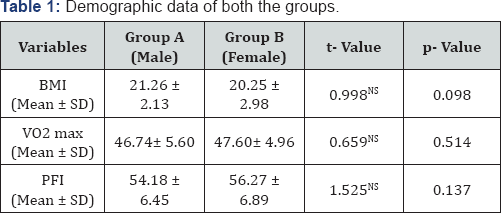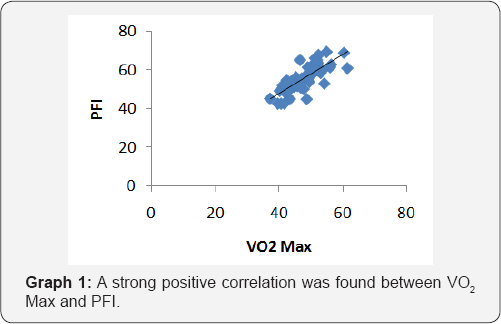Study on Cardio-Respiratory Fitness of Physiotherapy Students: A Cross-Sectional Study
Sonia Pawaria*, Sheetal Kalra and Sajjan Pal
Assistant Professor, Faculty of Physiotherapy, SGT University India
Submission: June 1, 2017; Published: June 27, 2017
*Corresponding author: Sonia Pawaria, Assistant Professor, Faculty of Physiotherapy, SGT University, Gurgaon, India, Email: pawaria_sonia@yahoo.co.in
How to cite this article: Sonia P, Sheetal K, Sajjan P. Study on Cardio-Respiratory Fitness of Physiotherapy Students: A Cross-Sectional Study. J Phy Fit Treatment & Sports. 2017; 1(2): 555558 DOI: 10.19080/JPFMTS.2017.01.555558
Abstract
Design: Cross-sectional Correlation study design.
Background: Cardio respiratory fitness reflects the overall capacity of the cardiovascular and respiratory systems and the ability to carry out prolonged exercise. Physiotherapist as trainers of fitness, they are themselves expected to have a good amount of fitness.
Objectives: To assess the cardio-respiratory fitness of Physiotherapy students.
Methods: 40 Physiotherapist students were selected through convenience random sampling for the study. Height and weight were measured to calculate the BMI of the students. VO2 max, and Physical fitness index of the students were evaluated through Harved step test.
Results: Results of the study reveled that cardio-respiratory fitness of the Physiotherapist students was average. There was a strong positive correlation between VO2 max, and Physical fitness index.
Conclusion: To achieve good cardio-respiratory fitness students should engage themselves in physical activities. Institutions should include some physical exercises in their curriculum.
Keywords: Cardio respiratory fitness; VO2 max; Physical Fitness Index
Introduction
Physical fitness is the basis of all the activities of our society. Cardio respiratory fitness reflects the overall capacity of the cardiovascular and respiratory systems and the ability to carry out prolonged exercise. Therefore, cardio respiratory fitness is considered as a direct measure of the physiologic status of the individual [1].
A sedentary lifestyle and low physical fitness are the most prevalent modifiable risk factor and predictor of both cardiovascular disease and all causes of morbidity and mortality. It has been found that high levels of cardio respiratory fitness provides strong and independent prognostic information about the overall risk of illness and death, related to cardiovascular causes [2].
Now days, demands of Physiotherapy profession is increasing day by day. For this, Physiotherapist is required to be engaged in various activities. The therapists work in hospitals and in rehabilitation centers with varieties of patients. Their work involves giving various exercises to patient, transferring of patients for that they need good amount of strength, endurance and flexibility. Therefore they have to maintain a good physical fitness level to meet their demands. But due to poor attention given to the physical fitness, it has been reported that there is increased prevalence of musculoskeletal disorder among the Physiotherapists as well as students. As trainers of fitness, they are themselves expected to have a good amount of fitness.
This study was done to find out the fitness level of Physiotherapy students and to compare the cardio respiratory fitness level of both male and females.
Methodology
This study was a cross-sectional correlation study design. The study was carried out in Faculty of Physiotherapy, SGT University, and Gurgaon. A sample of 40 Physiotherapy students both male and females were selected through convenience random sampling. Students suffering from any physical or medical abnormalities like cardiopulmonary disorders, endocrine disorders, chronic disease which affects physical fitness were excluded from the study. Those students who were involved in any kind of physical training, also excluded from the study. All the students were in the age group of 17-22 years. They were divided into Group A (Male) and Group B (female). Their height and weight were measured.
Written informed consents were taken from all the subjects. Subjects were instructed to take their last meal at least two hours before conducting the test to prevent the specific dynamic action of food. All the tests and measurements were taken at room temperature. Sufficient rest was given to all subjects before each procedure to get accurate result.
The fitness level of each participant was found out by performing the following tests:
BMI: It is calculated by using the formula
BMI= Weight (Kg)/Height2 (m)
Assessment of VO2Max: It is an indicator of maximum aerobic power. It is also known as the maximum oxygen consumption or maximum oxygen uptake. It was calculated by using Harved Step Test. In this test pulse was measured for one complete minute immediately after exercise and body weight was obtained from Body weight scale. Body weight and pulse rate was joined in the Astrand's Rythming Nomogram to obtain the value of VO2Max [3].
Assessment of Physical Fitness Index (PFI): It was calculated by measuring heart rate after performing Harved Step Test. It is based upon the heart rate recovery following a work load of 5 minutes. The participants in this test were instructed to step up and down on 51cm high bench for 5 minutes or up to the exhaustion level of participants. Exhaustion level is that time when the participant cannot maintain the stepping rate for 15 seconds, in case the rate of stepping is set at 30 cycles per minutes. Each cycle constituted step up and step down. At the end of this protocol immediately the participants was asked to sit down. After this the pulse was counted between 1 to 1.5 minutes, 2 to 2.5 minutes and 3 to 3.5 minutes.
The protocol of the study was approved by the Departmental Research Committee of Faculty of Physiotherapy.
Data Analysis & Result
Mean and standard deviation were calculated for all the parameters. Statistical analysis was done by SPSS, using unpaired t-test to find out the differences in means were statistically significant or not between the Groups. Karl Pearson Correlation test was used to find out the correlation between BMI and VO2 max and Physical fitness index. A 'P' value of less than 0.05 (p<0.05) was considered to be statistically significant.
Table 1 represents the demographic characteristics of both male and females. The Mean ± SD of BMI of Group A (male) was 21.26 ± 2.13 and of Group B (female) was 20.25 ± 2.98. The Mean ± SD of VO2 max of Group A (male) was 46.74± 5.60 and of Group B (female) was47.60± 4.96. The Mean ± SD of Physical fitness index (PFI) of both the groups was 54.18 ± 6.45 and 56.27 ± 6.89 respectively. There was no significant difference (p<0.05) between the demographic data of both the groups.

NS- Non significant

NS- Non significant, * - Significant, **- Highly significant
Table 2 represents the correlation between the physical fitness parameters. There was a non significant correlation both between BMI and VO2 Max and between BMI and PFI (p<0.05) (Graph 1).

Discussion
Physical fitness specifically Cardio-respiratory is important consideration for Physiotherapy students as they are involved in multiple activities during their clinical postings in OPD, clinics and hospitals such as transferring, shifting, lifting during managing paraplegics & quadriplegics patients in hydrotherapy pools, mobilizing patients in ICU. It is reported cardio-respiratory fitness is needed for rhythmic use of the body's large muscle groups. A high level of Cardio-respiratory fitness permits continuous physical activity without a decline in performance and allows for rapid recovery following fatiguing physical activity [4].
The purpose of this study was to evaluate the cardiorespiratory fitness of Physiotherapist students and also to compare the fitness between male and females. The result of the study revealed that the BMI of all the students were in normal range. The Physical Fitness index and VO2 max of the Physiotherapist students were found average.
It is observed that lower level of aerobic capacity among Physiotherapy graduate students is associated with low level of physical activity [5]. It is well established that active life style is a central component in the maintenance of good health and disease prevention. As a health promoting behavior the Physiotherapists need to be have a good level of fitness, not only for their personal health benefits, but also to allow them to represents as role models as Physiotherapist also work as fitness trainers in various Gymnasium. Therefore it is desirable for the promotion of physical activity among Physiotherapist students.
To maintain optimal level of fitness American College of Sports Medicine and American Heart Association have recommended that a healthy adult need to engage in moderate intensity physical activities for a minimum of 30 min, 5 day each week or vigorous intensity physical activities for a minimum of 20 min, 3 day each week [6].
It is observed that most of the students are not able to do their routine physical exercise because of their busy schedule. It is reported that poor engagement in exercise is associated with low level of oxygen consumption (VO2 max) [7].
Therefore it is suggested that to promote the physical fitness in Physiotherapy students, certain physical exercises should be included in the form of physical activity sessions their schedule by which they can participate in regular physical activity to achieve good fitness level.
Conclusion
It is found that Cardio-respiratory fitness of the Physiotherapists students was low therefore there is a need to motivate the students to achieve optimal level of fitness levels. It is recommended that the students should engage in physical activities. Institutions should include the different physical activities in their curriculum.
References
- Jonton Ruiz R (2007) Cardio-respiratory fitness and Cardiovascular disease risk factors in children and adolescents. Karolinska Instituted Stockholm p. 1-98.
- Mante L, Blair (2006) Physical activity, Cardio-respiratory fitness and adiposity: Contribution disease risk factors. Curr Oin Clin Nutr Metab Care 9(5): 540-546.
- Astrand PO, Rodahl K, Dahl H, Stromme S (1960) Test book of work Physiology4th( edn). p. 281.
- Jourks, Sadri (2011) Determination of fitness level in males and Females College aged students. Archives of Applied Sciences Research 3(2): 326-333.
- Gorner K, Tomasz B, JOze S (2005) Physical activity, body mass, body composition and the level of aerobic capacity among young adultwomen and men. Sports SPA 6 (2): 7-14.
- Nelson ME, Blair SN, Duncan PW (2007) Physical activity and public health in older adults: recommendation from the American College of Sports Medicine and American Heart Association. Circulation 116: 1435-1445.
- Ajediren IB, Emmanuel Bamney, Bridget Opoku (2016) Physical fitness of Ghanian Physiotherapists and its correlation with abe and exercise engagement ; a pilot study. Archives of Physiotherapy 6 (2).






























